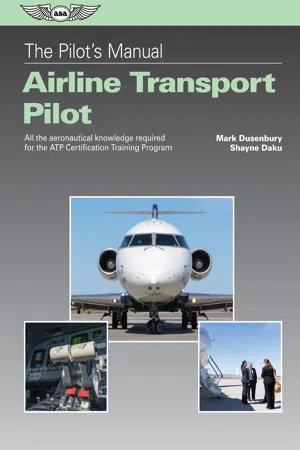![]()
Appendix 1
Glossary
aerodynamic ceiling. The altitude where the maximum speed limit (Mach limit) and the minimum speed limit (stall speed) meet.
aircraft communications addressing and reporting system (ACARS). A digital data link system for the transmission of messages between aircraft and ground stations.
air density. The mass of air in a given volume.
angle of attack (AOA). An angular measurement between the chord line of an airfoil and the relative wind.
anti-icing. The prevention of the formation of ice through the use of heat or by covering the surface with a chemical that prevents water from adhering to the surface.
augmented flight crew. A flight crew with more than the minimum number of flight crewmembers required by the airplane type certificate to operate the aircraft to allow a flight crewmember to be replaced by another qualified flight crewmember for inflight rest.
augmented operations. Flight operations in which more than the minimum number of required crew are available. Each member can leave their assigned duty station and be replaced by another qualified flight crewmember for the purpose of inflight rest.
Automatic Dependent Surveillance–Broadcast (ADS-B). A surveillance technology in which an aircraft determines its position via satellite navigation and periodically broadcasts it, enabling it to be tracked.
automation. The use of computer control systems that replace the need for human intervention.
Aviation Safety Action Program (ASAP). A program designed to encourage air carrier employees to voluntarily report safety information to the FAA. This information generally relates to safety and efficiency and usually identifies items that could result in incidents or accidents.
Aviation Safety Reporting System (ASRS). A system that receives and processes voluntarily submitted incident reports from aviation professionals.
calendar day. A 24-hour period from 0000 through 2359 using Coordinated Universal Time or local time.
center of gravity. A point around which all of the weight of an object is centered.
checklist. A systematic and sequential list of all operations that must be performed to properly accomplish a complex task.
clear air turbulence. Extreme turbulence found at high altitude, often in the absence of any visual clues (such as clouds).
communication. The transmission of ideas, concepts, thoughts, and feelings.
composite radar. Images created by taking radar returns from a number of ground-based radar units and “stitching” them together. The final image is a representation of what a person on the ground could see as precipitation.
configuration deviation list (CDL). The aircraft source document listing the parts and/or combinations of parts that are permitted to be missing for operation of an aircraft, and the associated performance reductions and other limitations, as determined and presented in the airplane flight manual.
countermeasures. A process, policy, or standardized format that seeks to appropriately handle both planned and unforeseen threats and errors.
crew resource management (CRM). The use of all available resources, information, equipment, and people to accomplish safe and efficient flight operations.
critical angle of attack. The highest angle of attack at which air passes over an airfoil in a smooth flow.
deadhead. Transportation of a flight crewmember as a passenger or non-operating flight crewmember, by any mode of transportation, as required by a certificate holder, excluding transportation to or from a suitable accommodation.
DECIDE Model. A six-step, continuous-loop process that provides pilots with a logical way of making decisions. DECIDE means to Detect, Estimate, Choose a course of action, Identify solutions, Do the necessary actions, and Evaluate the effects of the actions.
deicing. Removal of snow, ice or frost from a surface.
depressurization. A loss of pressure of the aircraft cabin, which can be caused by structural failure, system malfunction, or crew action.
digital communication. The use of a digital messaging system to deliver written communication between any number of people.
Dutch roll. An undesirable, low-amplitude oscillation about both the yaw and roll axes that affect many swept-wing airplanes.
error. An action or inaction by the flight crew that diverges from intentions or expectations.
fatigue. A physiological state of reduced mental or physical performance capability resulting from lack of sleep or increased physical activity that can reduce a flight crewmember’s alertness and ability to safely operate an aircraft or perform safety-related duties.
fatigue risk management system (FRMS). A management system for a certificate holder to use to mitigate the effects of fatigue in its particular operations. It is a data-driven process and a systematic method used to continuously monitor and manage safety risks associated with fatigue-related error.
final takeoff climb speed (VT). The target speed for a 14 CFR Part 25 certified aircraft to maintain while climbing in the fourth segment following an engine failure on takeoff.
flight duty period (FDP). A period that begins when a flight crewmember is required to report for duty with the intention of conducting a flight, a series of flights, or positioning or ferrying flights, and ends when the aircraft is parked after the last flight and there is no intention for further aircraft movement by the same flight crewmember. A flight duty period includes the duties performed by the flight crewmember on behalf of the certificate holder that occur before a flight segment or between flight segments without a required intervening rest period.
flight following. A system to ensure the proper monitoring of the progress of each flight with respect to its departure at the point of origin and arrival at its destination, including intermediate stops and diversions therefrom, and maintenance or mechanical delays encountered at those points or stops; and to ensure that the pilot-in-command is provided with all information necessary for the safety of the flight.
flight management systems (FMS). A computer system that uses a large database to allow routes to be preprogrammed and fed into the system by means of a data loader. The system is...
